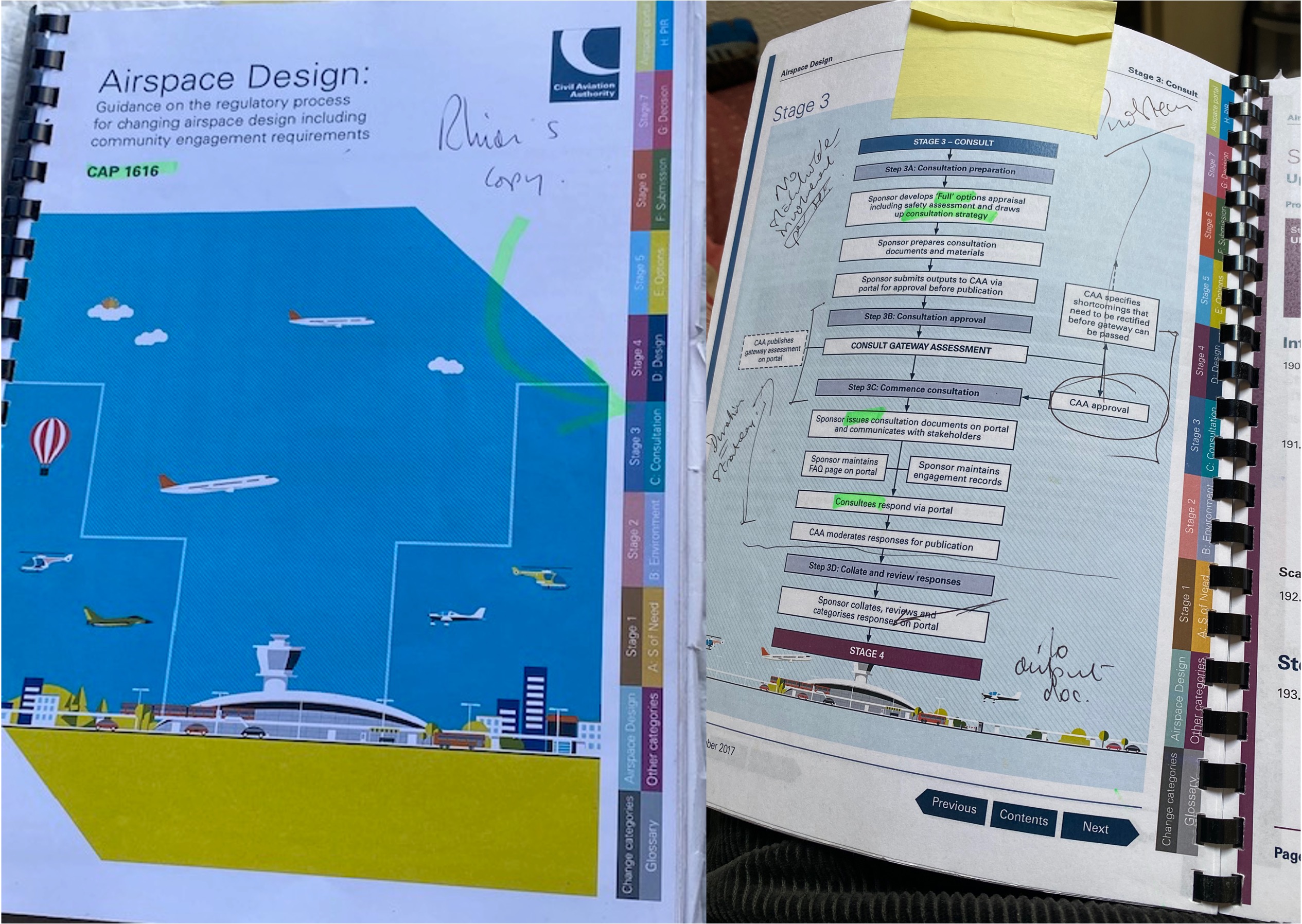This is Blog No 19
I have just responded to the Civil Aviation Authority’s consultation on changes to its Guidance on Airspace change.
It certainly needs changing!.

The current Guidance details a methodology whereby each airspace ‘change sponsor’ has to go through seven Stages and four ‘gateways’ in order to have its proposals for route changes approved by the Regulator. It’s called CAP1616 and is a demanding process. The latest version is an inch thick and 281 pages long ; the Glossary alone is 17 pages. Full compliance is a challenge but was thought necessary to ensure communities are properly involved.
But this is all ridiculous, as the CAA has known for years. It is repetitive, confuses regulatory requirements with advice on how to comply. User-friendly it isn’t. Which is just as well, because no-one but diehard bureaucrats would even open it. The current changes will effect some improvements and gives me the opportunity to promote the idea that every Airport embarking on airspace changes needs a Stakeholder Reference Group – and relies upon dialogue with them and local communities as to how best to engage and consult them – rather than a sterile tome telling them to do this or do that.
Okay – rant over, and in fairness to my good friends in the CAA, there are many other Regulators and public bodies guilty of similar follies.
This prompts serious questions about the role and style of Guidance. Almost everyone organising public engagement operates within some regime of Guidance or another. This is important because failure to observe the provisions of some of them can make public bodies vulnerable if legally challenged, all as a consequence of the doctrine of legitimate expectations.
I once invented a hierarchy of Guidance, starting with Statutory Guidance, then Ministerial Guidance, Departmental Guidance and so forth right down to recommended best practice from professional institutes (such as our own Consultation Institute). I sought to demonstrate that the level of ‘expectations’ they could create would differ.
In the case of CAP1616, the Regulator has always assumed that sooner or later an Airport will be subject to judicial review, and hoped that having such a comprehensive Guidance document might help. I have always thought the opposite – that the more detailed and prescriptive a set of Guidance might be, the more likely it might be that objectors will find non-conformances or other failures to adhere to every provision. Unless really significant, It might not win them a case, but it is a massive hostage to fortune and probably unnecessary.
What’s happened is that the culture of ‘cover my backside’ has permeated the profession of Guidance-writers. They have lost sight of the difference between Guidance and Practitioner Toolkits!
Examine the documentation that govern the public engagement and consultations in your own field – and whether you are a consultor – or a consultee. Maybe both? I am thinking of complex documentation in the NHS, Local government, the Police/Fire & Rescue … and hybrid public/private environments such as infrastructure planning and construction.
Do they help you distinguish between tasks that
- “We must comply with at all costs …’ or the Chief Exec resigns in acrimony
- “We should try hard to comply with”, but the implications of failure are manageable”
- “We should comply with if we can” – but no-one will mind if we do not
- “We can safely ignore” as few people understand them or care …”
And all nuances in between?
Flippancy aside, there is a real difficulty in striking the right balance between precision and best practice on the one hand and common sense and flexibility on the other. We haven't got it right. Far too many OTT Guidance documents threaten to suffocate the profession - draining it of life and stifling the imagination and innovation needed to engage and consult succesfully with stakeholders and the community.
Remember, we are moving away from public involvement in policy-making and decision-making being a minority sport for the ‘usual suspects’ at the old-fashioned public meeting. We have contentious behaviour changes looming due to socio-economic changes, demographics and, of course climate change/net zero. We need to carry people with us. Engagement and consultation has to become a mainstream activity and the nineteen-year old asking how the system works from his mobile or wristwatch will not be happy being referred to CAP1616-style mega-docs.
The Civil Aviation Authority, is, from my experience among the most professional, well managed of all our Regulators. And it is absolutely right to revise and amend its Guidance. But let’s raise the issue with other public bodies – and move with the times.
Keep Guidance as simple as possible, but simultaneously train best practice to the highest standards practicable. And there are better ways to do that than publishing a massive Toolkit!
See Rhion's Speeches, Talks and Presentations.
For More like this - free of charge: SUBSCRIBE now
Leave a Comment
I hope you enjoyed this post. If you would like to, please leave a comment below.